-
 Iron tsuba of mokko form (quatrefoil) decorated with a pair of cherry blossoms (sakura) in small openwork (ko-sukashi) and inlaid in brass (suemon-zōgan) with designs of waves, distant pines, chrysanthemum flowers in halves, tendrils and leaves, lightning or thunder symbol (inazuma), flying geese and family chrests (mon): two interlocked rings (wachigai) on the face, and three encircled stripes (maru-no-uchi-ni-mitsuhikiryo) - kamon of the Kikkawa clan - on the reverse. Hitsu-ana outlined with inlay of brass wire. Surface treated with lacquer. Copper sekigane. Though some consider this type of tsuba to resemble Heianjo school, “...the brass trim around the hitsu-ana is a characteristics of Ōnin work” [Japanese sword guards. Onin – Heianjo – Yoshiro. Gary D. Murtha. GDM Publications, 2016; p. 27.]. The Ōnin origin is reinforced by scattered ten-zōgan elements here and there through the plate. It is possible that the tsuba was initially of round form and later trimmed to mokko shape. Mid Muromachi period; 15th century. Dimensions: Height: 87.2 mm; Width: 87.9 mm; Thickness at seppa-dai: 3.6 mm.
Iron tsuba of mokko form (quatrefoil) decorated with a pair of cherry blossoms (sakura) in small openwork (ko-sukashi) and inlaid in brass (suemon-zōgan) with designs of waves, distant pines, chrysanthemum flowers in halves, tendrils and leaves, lightning or thunder symbol (inazuma), flying geese and family chrests (mon): two interlocked rings (wachigai) on the face, and three encircled stripes (maru-no-uchi-ni-mitsuhikiryo) - kamon of the Kikkawa clan - on the reverse. Hitsu-ana outlined with inlay of brass wire. Surface treated with lacquer. Copper sekigane. Though some consider this type of tsuba to resemble Heianjo school, “...the brass trim around the hitsu-ana is a characteristics of Ōnin work” [Japanese sword guards. Onin – Heianjo – Yoshiro. Gary D. Murtha. GDM Publications, 2016; p. 27.]. The Ōnin origin is reinforced by scattered ten-zōgan elements here and there through the plate. It is possible that the tsuba was initially of round form and later trimmed to mokko shape. Mid Muromachi period; 15th century. Dimensions: Height: 87.2 mm; Width: 87.9 mm; Thickness at seppa-dai: 3.6 mm. -
 Iron tsuba of round form decorated with floral motif in brass or copper inlay (suemon-zōgan) and family crests (mon) in small openwork (ko-sukashi). Occasional brass dots or nail heads in brass ten-zōgan. Sukashi elements outlined with inlaid brass wire. Seppa-dai outlined with rope-shaped brass wire (nawame-zōgan); kozuka-hitsu-ana outlined with scalloped brass wire. Ōnin school. Mid to late Muromachi period, 15th or 16th century. Height: 88.9 mm; Width: 88.5 mm; Thickness at seppa-dai: 2.9 mm. Family crests (mon) in openwork: cherry blossom (sakura) - kamon of Sakurai and Yoshino clans, four-section lozenge (waribishi) - kamon of Takeda clan, the seven stars of the big dipper (maru ni nanatsuboshi) - kamon of Chiba clan, two encircled stripes (futatsubiki) - kamon of Ashikaga clan. Brass inlays represent flowers, branches and leaves, as well as halved plum blossom, halved chrysanthemum blossom, cloud, and chrysanthemum-on-water symbol - the mon of Kusunoki Masashige. Abundance of family crests of so many powerful warrior clans symbolizes heritage. "The brass trim around the kozuka hitsu-ana andd the seppa-dai are characteristics of Onin work" [Japanese sword guards. Onin - Heianjo - Yoshiro. Gary D. Murtha. GDM Publications, 2016; p. 27.]
Iron tsuba of round form decorated with floral motif in brass or copper inlay (suemon-zōgan) and family crests (mon) in small openwork (ko-sukashi). Occasional brass dots or nail heads in brass ten-zōgan. Sukashi elements outlined with inlaid brass wire. Seppa-dai outlined with rope-shaped brass wire (nawame-zōgan); kozuka-hitsu-ana outlined with scalloped brass wire. Ōnin school. Mid to late Muromachi period, 15th or 16th century. Height: 88.9 mm; Width: 88.5 mm; Thickness at seppa-dai: 2.9 mm. Family crests (mon) in openwork: cherry blossom (sakura) - kamon of Sakurai and Yoshino clans, four-section lozenge (waribishi) - kamon of Takeda clan, the seven stars of the big dipper (maru ni nanatsuboshi) - kamon of Chiba clan, two encircled stripes (futatsubiki) - kamon of Ashikaga clan. Brass inlays represent flowers, branches and leaves, as well as halved plum blossom, halved chrysanthemum blossom, cloud, and chrysanthemum-on-water symbol - the mon of Kusunoki Masashige. Abundance of family crests of so many powerful warrior clans symbolizes heritage. "The brass trim around the kozuka hitsu-ana andd the seppa-dai are characteristics of Onin work" [Japanese sword guards. Onin - Heianjo - Yoshiro. Gary D. Murtha. GDM Publications, 2016; p. 27.] -
 Iron tsuba of round form decorated with two boar's eyes (inome) and two dragonflies (tombo) in small openwork (ko-sukashi) outlined with brass wire. The plate also decorated with 2 to 5 concentric circular rows of brass dots (nail heads) in ten-zōgan. Center of the plate outlined with the inlaid circular brass wire. The inlaid metal is of red-ish hue, so it may be copper, and not brass. The surface has remnants of lacquer. Ōnin school. Mid Muromachi period, middle of 15th century. Dimensions: Diameter: 90 mm, thickness: 3.2 mm. Notes regarding design: "According to various sources, the dragonfly (tombo) is emblematic of martial success, as various names for the insect are homophones for words meaning "victory". The dragonfly is also auspicious because references in the Kojiki and Nihongi link it in both name and shape to the old kingdom of Yamato." [Merrily Baird. Symbols of Japan. Thematic motifs in art and design. Rizzoli international publications, Inc., 2001, p. 108]. "The dragonfly (tonbo), was also called kachimushi in earlier times, and due to the auspicious literal meaning "victory bug" of the characters of this word it became a popular theme on sword fittings." [Iron tsuba. The works of the exhibition "Kurogane no hana", The Japanese Sword Museum, 2014, p. 13]. Two other cutouts - in the form of what in European tradition symbolizes the heart, on the top and in the bottom of tsuba disc - may have two different explanations. The most usual one, inome - "Heart-shaped pattern, which is said to go back to the shape of a wild boar's eye" [Markus Sesko. Encyclopedia of Japanese Swords. Print and publishing: Lulu Enterprises, Inc., 2014.]. This understanding is shared by Robert Haynes [Robert E. Haynes. Study Collection of Japanese Sword Fittings. Nihon Art Publishers, 2010.] and elsewhere, with an exception of Okabe-Kakuya [Okabe-Kakuya. JAPANESE SWORD GUARDS. Museum of Fine Arts, Boston. In cooperation with the department of Chinese and Japanese art; - 1908, p. 14], who provides the illustration of inome-shaped cut-outs with the following explanation: " The tsuba shown in Fig. 13 approaches a square form with rounded corners and is perforated with Aoi decoration. But this book was written long time ago, when people even at MFA might not know enough...
Iron tsuba of round form decorated with two boar's eyes (inome) and two dragonflies (tombo) in small openwork (ko-sukashi) outlined with brass wire. The plate also decorated with 2 to 5 concentric circular rows of brass dots (nail heads) in ten-zōgan. Center of the plate outlined with the inlaid circular brass wire. The inlaid metal is of red-ish hue, so it may be copper, and not brass. The surface has remnants of lacquer. Ōnin school. Mid Muromachi period, middle of 15th century. Dimensions: Diameter: 90 mm, thickness: 3.2 mm. Notes regarding design: "According to various sources, the dragonfly (tombo) is emblematic of martial success, as various names for the insect are homophones for words meaning "victory". The dragonfly is also auspicious because references in the Kojiki and Nihongi link it in both name and shape to the old kingdom of Yamato." [Merrily Baird. Symbols of Japan. Thematic motifs in art and design. Rizzoli international publications, Inc., 2001, p. 108]. "The dragonfly (tonbo), was also called kachimushi in earlier times, and due to the auspicious literal meaning "victory bug" of the characters of this word it became a popular theme on sword fittings." [Iron tsuba. The works of the exhibition "Kurogane no hana", The Japanese Sword Museum, 2014, p. 13]. Two other cutouts - in the form of what in European tradition symbolizes the heart, on the top and in the bottom of tsuba disc - may have two different explanations. The most usual one, inome - "Heart-shaped pattern, which is said to go back to the shape of a wild boar's eye" [Markus Sesko. Encyclopedia of Japanese Swords. Print and publishing: Lulu Enterprises, Inc., 2014.]. This understanding is shared by Robert Haynes [Robert E. Haynes. Study Collection of Japanese Sword Fittings. Nihon Art Publishers, 2010.] and elsewhere, with an exception of Okabe-Kakuya [Okabe-Kakuya. JAPANESE SWORD GUARDS. Museum of Fine Arts, Boston. In cooperation with the department of Chinese and Japanese art; - 1908, p. 14], who provides the illustration of inome-shaped cut-outs with the following explanation: " The tsuba shown in Fig. 13 approaches a square form with rounded corners and is perforated with Aoi decoration. But this book was written long time ago, when people even at MFA might not know enough... The same interpretation of the said heart-like symbol (aoi leaf) is given at Helen C. Gunsaulus. Japanese sword-mounts in the collection of Field Museum. // Publication 216, Anthropological Series, Volume XVI; Chicago, 1923; p. 54: "This mokkō-formed tsuba recalls the aoi form, perforated as it is with the four aoi leaves." It is possible that the "wild boar's eye" theory was developed by later scholars.
The same interpretation of the said heart-like symbol (aoi leaf) is given at Helen C. Gunsaulus. Japanese sword-mounts in the collection of Field Museum. // Publication 216, Anthropological Series, Volume XVI; Chicago, 1923; p. 54: "This mokkō-formed tsuba recalls the aoi form, perforated as it is with the four aoi leaves." It is possible that the "wild boar's eye" theory was developed by later scholars.
 There is also a theory, supported by Graham Gemmell, saying that: “In simple terms Onin works are decorated Ko-Katchushi tsuba. … But, not content with iron alone, they began to decorate it with what was, in the early Muromachi period, a rare and valuable metal, brass. The Onin workers cut the design into the iron, using narrow channels, cast the brass, piece by piece, and then hammered it into the iron plate as though they were putting together a jigsaw. When complete the tsuba would be black lacquered exactly as the plain iron ones had been, the brass shining dully through it in a way that fulfilled the goal of shibui or restrained elegance.” [Tosogu. Treasure of the samurai. Fine Japanese Sword Fittings from The Muromachi to The Meiji Period, by Graham Gemmell. // Sarzi-Amadè Limited, London, 1991. An exhibition held in London from 21st March to 4th April, 1991]. The following illustration from Helen C. Gunsaulus. Japanese sword-mounts in the collection of Field Museum. // Publication 216, Anthropological Series, Volume XVI; Chicago, 1923; pp. 43 supports the idea.
There is also a theory, supported by Graham Gemmell, saying that: “In simple terms Onin works are decorated Ko-Katchushi tsuba. … But, not content with iron alone, they began to decorate it with what was, in the early Muromachi period, a rare and valuable metal, brass. The Onin workers cut the design into the iron, using narrow channels, cast the brass, piece by piece, and then hammered it into the iron plate as though they were putting together a jigsaw. When complete the tsuba would be black lacquered exactly as the plain iron ones had been, the brass shining dully through it in a way that fulfilled the goal of shibui or restrained elegance.” [Tosogu. Treasure of the samurai. Fine Japanese Sword Fittings from The Muromachi to The Meiji Period, by Graham Gemmell. // Sarzi-Amadè Limited, London, 1991. An exhibition held in London from 21st March to 4th April, 1991]. The following illustration from Helen C. Gunsaulus. Japanese sword-mounts in the collection of Field Museum. // Publication 216, Anthropological Series, Volume XVI; Chicago, 1923; pp. 43 supports the idea.
 Helen C. Gunsaulus' description of the dragonfly emblem is as follows: "This motive, the dragon-fly (akitsu), is generally accepted as a symbol of the kingdom of Japan, and the origin of the idea is traced to the legend recounted in the Kojiki and Nihongo of the Emperor Jimmu's view of the island from mountain top. He is said to have thought the kingdom looked like a dragon-fly touching its tail with its mouth. From this it received its name Akitsu-shima... etc."
Helen C. Gunsaulus' description of the dragonfly emblem is as follows: "This motive, the dragon-fly (akitsu), is generally accepted as a symbol of the kingdom of Japan, and the origin of the idea is traced to the legend recounted in the Kojiki and Nihongo of the Emperor Jimmu's view of the island from mountain top. He is said to have thought the kingdom looked like a dragon-fly touching its tail with its mouth. From this it received its name Akitsu-shima... etc."
-
 Iron tsuba of round form with design of military commander's fan (gunbai) in openwork (sukashi). Square rim. Hitsu-ana plugged with lead or tin. Ko-tosho school. Mid-Muromachi period (1454-1513), Entoku era (1489-92) / Meio era (1489-1501). Height: 80.3 mm, Width: 81.5 mm, Rim thickness: 3.0 mm. Centre thickness: 3.5 mm. Provenance: Sasano Masayuki Collection, №23 in Japanese Sword Guard Masterpieces from the Sasano Collection, 1994: Ko-tosho. Sukashi design: Military commander's fan (gunbai). Mid Muromachi period. Late 15th century (Entoku / Meio era). The military commander's fan (gunbai) was cherished by samurai warriors. This tsuba is relatively thick, with the large fan nicely positioned on the plate.
Iron tsuba of round form with design of military commander's fan (gunbai) in openwork (sukashi). Square rim. Hitsu-ana plugged with lead or tin. Ko-tosho school. Mid-Muromachi period (1454-1513), Entoku era (1489-92) / Meio era (1489-1501). Height: 80.3 mm, Width: 81.5 mm, Rim thickness: 3.0 mm. Centre thickness: 3.5 mm. Provenance: Sasano Masayuki Collection, №23 in Japanese Sword Guard Masterpieces from the Sasano Collection, 1994: Ko-tosho. Sukashi design: Military commander's fan (gunbai). Mid Muromachi period. Late 15th century (Entoku / Meio era). The military commander's fan (gunbai) was cherished by samurai warriors. This tsuba is relatively thick, with the large fan nicely positioned on the plate. -
 Iron tsuba of round form decorated with eight circular emblems of flowers and/or family crests (mon) made of cast brass, pierced and chiseled in kebori, as well as with flat brass inlay (hira-zōgan) of vines, leaves, and flowers all over the plate. Yoshirō school (Kaga-Yoshirō). The Momoyama or early Edo period, 17th century. Size: diameter 80 mm, thickness at seppa-dai 3,6 mm. Symbols: [12:00 o'clock] - Wood sorrel (katabami) and swords ; [9:00] - Cherry blossom (sakura); [7:30] - Bellflower (kikyō), kamon of Toki clan; [3:00] - possibly, a six-petal Chrysanthemum (kiku) or a Passion flower (tessen); [1:30] - Hemp (asanoha). The symbols at 6:00, 10:30, and 4:30 o'clock seem to be geometrical patterns of auspicious meaning: a cross in a square, a four pointing star, and a diamond, respectively. Alternatively, we may look at this piece as purely decorative, with patterns at 12:00, 3:00, 6:00, and 9:00 o'clock in negative openwork (in-sukashi), and at 1:30, 4:40, 7:20, and 10:30 o'clock - in positive openwork (ji-sukashi, or yō-sukashi). Markus Sesko in his Handbook of sword fittings related terms [Herstellung und Verlag: Books on Demand GmbH, Norderstedt, 2011] discriminates this type of openwork in a separate class: Ranma-sukashi: "This term is applied to circular sukashi with family crests to their inside, which are arranged running along the rim area. The description goes back to the opened boards (ranma) between the sliding doors and the ceiling of Japanese rooms. Ranma-sukashi are mostly seen on old Heianjō- or Yoshirō-zōgan-tsuba but also on works of Hayashi Matashichi" [page 30].
Iron tsuba of round form decorated with eight circular emblems of flowers and/or family crests (mon) made of cast brass, pierced and chiseled in kebori, as well as with flat brass inlay (hira-zōgan) of vines, leaves, and flowers all over the plate. Yoshirō school (Kaga-Yoshirō). The Momoyama or early Edo period, 17th century. Size: diameter 80 mm, thickness at seppa-dai 3,6 mm. Symbols: [12:00 o'clock] - Wood sorrel (katabami) and swords ; [9:00] - Cherry blossom (sakura); [7:30] - Bellflower (kikyō), kamon of Toki clan; [3:00] - possibly, a six-petal Chrysanthemum (kiku) or a Passion flower (tessen); [1:30] - Hemp (asanoha). The symbols at 6:00, 10:30, and 4:30 o'clock seem to be geometrical patterns of auspicious meaning: a cross in a square, a four pointing star, and a diamond, respectively. Alternatively, we may look at this piece as purely decorative, with patterns at 12:00, 3:00, 6:00, and 9:00 o'clock in negative openwork (in-sukashi), and at 1:30, 4:40, 7:20, and 10:30 o'clock - in positive openwork (ji-sukashi, or yō-sukashi). Markus Sesko in his Handbook of sword fittings related terms [Herstellung und Verlag: Books on Demand GmbH, Norderstedt, 2011] discriminates this type of openwork in a separate class: Ranma-sukashi: "This term is applied to circular sukashi with family crests to their inside, which are arranged running along the rim area. The description goes back to the opened boards (ranma) between the sliding doors and the ceiling of Japanese rooms. Ranma-sukashi are mostly seen on old Heianjō- or Yoshirō-zōgan-tsuba but also on works of Hayashi Matashichi" [page 30]. -
 Iron tsuba of round form decorated with eight roundels – circular emblems of flowers and/or family crests (mon) made of cast brass, pierced and chiseled in kebori, and with flat brass inlay (hira-zōgan) of vines or leaves all over the plate. Both hitsu-ana trimmed in brass. Nakago-ana of rectangular form, with copper sekigane. Four positive openwork (ji-sukashi) roundels at 12, 3, 6, and 9 o'clock; and four negative openwork (in-sukashi) roundels with cherry blossom, bellflower, and two variations on suhama theme. Yoshirō school (Kaga-Yoshirō). The Momoyama or early Edo period, late 16th to early 17th century. Size: diameter 81.4 mm, thickness 4.7 mmat seppa-dai, 4.0 mm at rim. Christie's lot description: AN IRON TSUBA; EDO PERIOD (17TH CENTURY). THE DOLPHYN COLLECTION OF SAMURAI ART. The round iron tsuba pierced with roundels of various floral motifs interspersed among scrolling foliage, all inlaid with brass. 8.1 cm. high. Provenance: Pabst Collection (no. 338).
Iron tsuba of round form decorated with eight roundels – circular emblems of flowers and/or family crests (mon) made of cast brass, pierced and chiseled in kebori, and with flat brass inlay (hira-zōgan) of vines or leaves all over the plate. Both hitsu-ana trimmed in brass. Nakago-ana of rectangular form, with copper sekigane. Four positive openwork (ji-sukashi) roundels at 12, 3, 6, and 9 o'clock; and four negative openwork (in-sukashi) roundels with cherry blossom, bellflower, and two variations on suhama theme. Yoshirō school (Kaga-Yoshirō). The Momoyama or early Edo period, late 16th to early 17th century. Size: diameter 81.4 mm, thickness 4.7 mmat seppa-dai, 4.0 mm at rim. Christie's lot description: AN IRON TSUBA; EDO PERIOD (17TH CENTURY). THE DOLPHYN COLLECTION OF SAMURAI ART. The round iron tsuba pierced with roundels of various floral motifs interspersed among scrolling foliage, all inlaid with brass. 8.1 cm. high. Provenance: Pabst Collection (no. 338). -
 Iron tsuba of round form decorated with design of pine tree mushrooms (matsutake) in openwork (sukashi). Hitsu-ana of elongated oval form. Raised rim (mimi) with iron bones (tekkotsu). Copper sekigane. Size: 84.5 mm x 85.1 mm; thickness: 3.0 mm (center), 5.6 mm (rim). Mid Muromachi period, 15th century. The shape and width of the rim, as well as the shape of the hitsu-ana, argue for earlier Muromachi. Tsuba is slightly wider than high, that might suggest middle of Muromachi age. According to Robert Haynes, circa 1450-1500.
Iron tsuba of round form decorated with design of pine tree mushrooms (matsutake) in openwork (sukashi). Hitsu-ana of elongated oval form. Raised rim (mimi) with iron bones (tekkotsu). Copper sekigane. Size: 84.5 mm x 85.1 mm; thickness: 3.0 mm (center), 5.6 mm (rim). Mid Muromachi period, 15th century. The shape and width of the rim, as well as the shape of the hitsu-ana, argue for earlier Muromachi. Tsuba is slightly wider than high, that might suggest middle of Muromachi age. According to Robert Haynes, circa 1450-1500. -
 Iron tsuba of slightly elongated round form decorated with design of melon flowers, vines, and leaves in brass flat inlay (hira-zōgan) on both sides. Slightly raised rim (mimi) carved in a way to simulate ring-shaped covering (fukurin). Kozuka hitsu-ana and kogai hitsu-ana both plugged with soft metal (tim or lead). Copper sekigane. Heianjō or Kaga School. Muromachi or Momoyama period, 16th century. Iron, hira-zōgan brass inlay. Round (maru gata) form, diameter 79 mm. Size: 80.3 x 78.4 mm; thickness at seppa-dai: 3.4 mm; at the middle: 3.8 mm; before the rim: 2.4 mm, rim: 2.8 mm. Note on design: though this design resembles family crests with oak and mulberry leaves, I believe it's a melon flower [see Jeanne Allen. Designer's guide to Samurai Patterns. Chronicle Books, San Francisco, 1990, page 114, №130 "Melon Flowers":Note about the distribution of thickness (niku-oki): "this tsuba has toroid features, niku raises from the rim towards the centre but thins once more out when approaching the seppa-dai" [M. Sesko, "Handbook...", p. 48].
Iron tsuba of slightly elongated round form decorated with design of melon flowers, vines, and leaves in brass flat inlay (hira-zōgan) on both sides. Slightly raised rim (mimi) carved in a way to simulate ring-shaped covering (fukurin). Kozuka hitsu-ana and kogai hitsu-ana both plugged with soft metal (tim or lead). Copper sekigane. Heianjō or Kaga School. Muromachi or Momoyama period, 16th century. Iron, hira-zōgan brass inlay. Round (maru gata) form, diameter 79 mm. Size: 80.3 x 78.4 mm; thickness at seppa-dai: 3.4 mm; at the middle: 3.8 mm; before the rim: 2.4 mm, rim: 2.8 mm. Note on design: though this design resembles family crests with oak and mulberry leaves, I believe it's a melon flower [see Jeanne Allen. Designer's guide to Samurai Patterns. Chronicle Books, San Francisco, 1990, page 114, №130 "Melon Flowers":Note about the distribution of thickness (niku-oki): "this tsuba has toroid features, niku raises from the rim towards the centre but thins once more out when approaching the seppa-dai" [M. Sesko, "Handbook...", p. 48].
Jeanne Allen. Designer's guide to Samurai Patterns. Chronicle Books, San Francisco, 1990. Page 114, №130.
-
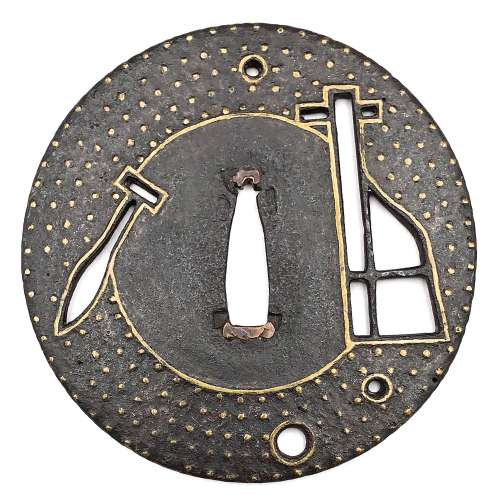 Iron tsuba of round form with design of rudder, paddle, and stars in small openwork (ko-sukshi) outlined with brass wire, and further decorated with inlay of five concentric rows of brass dots or nail heads (ten-zōgan) and circular brass wire inlaid inside the innermost row of dots. Two lower round openings may also serve as udenuki-ana. Copper sekigane. Unsigned. Late Muromachi or Momoyama period, 16th century. Diameter: 90.4 x 89.8 x 2.8 mm.
Iron tsuba of round form with design of rudder, paddle, and stars in small openwork (ko-sukshi) outlined with brass wire, and further decorated with inlay of five concentric rows of brass dots or nail heads (ten-zōgan) and circular brass wire inlaid inside the innermost row of dots. Two lower round openings may also serve as udenuki-ana. Copper sekigane. Unsigned. Late Muromachi or Momoyama period, 16th century. Diameter: 90.4 x 89.8 x 2.8 mm. -
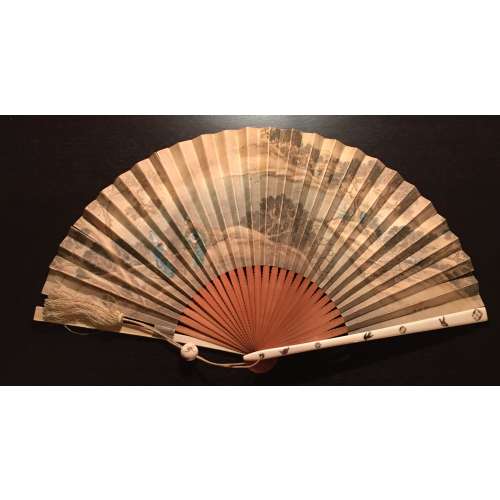 Late 19th-century (1850-1870) Japanese export fan. This fan has a double leaf painted with a different design on either side. Ivory encrusted with gemstones (birds and shippomon motif). Painting by ukiyo-e artist and printmaker Katsushika Isai (1821–1880) represents a riverside landscape with figures; birds and flowers on the reverse. Signed: Isai ga (為斎画) - "Painted by Isai".
Late 19th-century (1850-1870) Japanese export fan. This fan has a double leaf painted with a different design on either side. Ivory encrusted with gemstones (birds and shippomon motif). Painting by ukiyo-e artist and printmaker Katsushika Isai (1821–1880) represents a riverside landscape with figures; birds and flowers on the reverse. Signed: Isai ga (為斎画) - "Painted by Isai". -
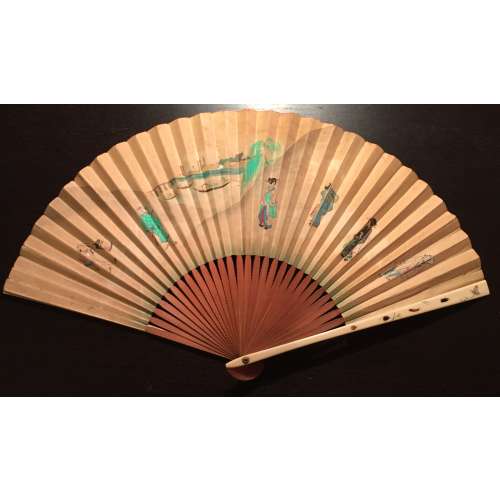 Late 19th-century (1850-1870) Japanese export fan. This fan has a double leaf painted with a different design on either side. Ivory encrusted with gemstones and other materials. Subject matter such as women wearing kimono is also more typical of export than domestic products (V&A). Summer (birds and flowers) theme on the reverse.
Late 19th-century (1850-1870) Japanese export fan. This fan has a double leaf painted with a different design on either side. Ivory encrusted with gemstones and other materials. Subject matter such as women wearing kimono is also more typical of export than domestic products (V&A). Summer (birds and flowers) theme on the reverse. -
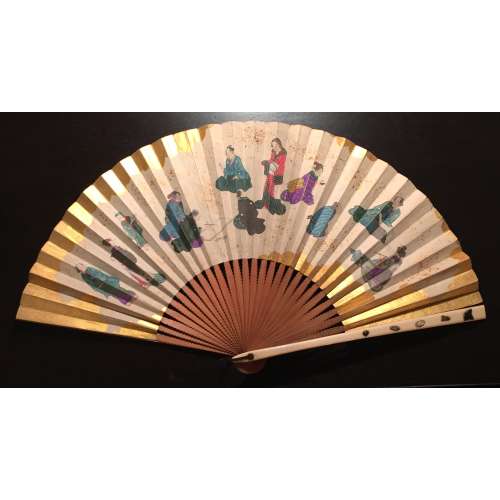 Late 19th-century (1850-1870) Japanese export fan. This fan has a double leaf painted with a different design on either side. Ivory encrusted with gemstones and other materials. Subject matter such as women wearing kimono is also more typical of export than domestic products (V&A). Autumn theme on the reverse.
Late 19th-century (1850-1870) Japanese export fan. This fan has a double leaf painted with a different design on either side. Ivory encrusted with gemstones and other materials. Subject matter such as women wearing kimono is also more typical of export than domestic products (V&A). Autumn theme on the reverse. -
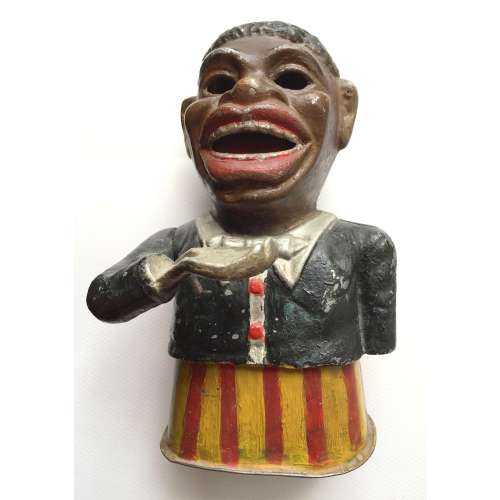 A cast iron painted 19th century style money box in the form of a negro, the arm articulated to insert coins.
A cast iron painted 19th century style money box in the form of a negro, the arm articulated to insert coins. -
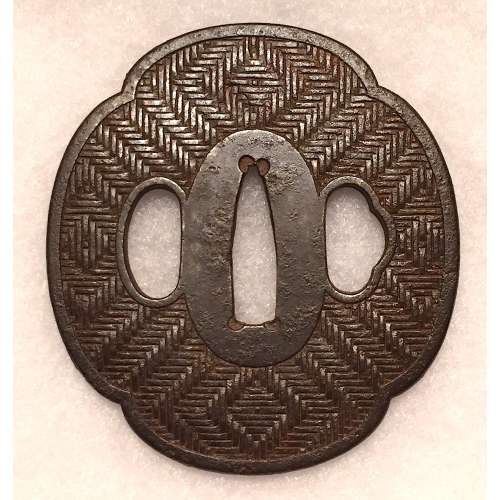 Iron tsuba with brown patina in mokkō-gata form with woven design. Size: 72 x 67 x 5 mm.
Iron tsuba with brown patina in mokkō-gata form with woven design. Size: 72 x 67 x 5 mm. -
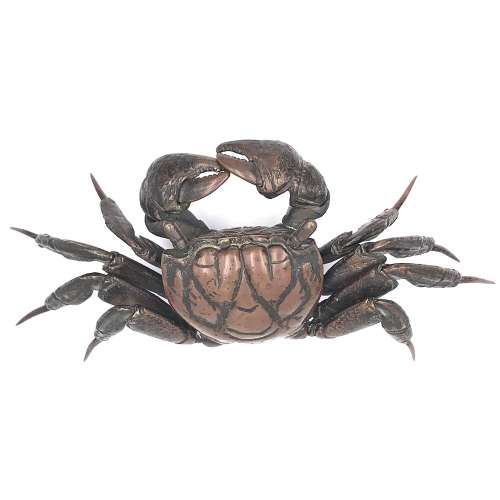 Jizai okimono bronze articulated model of a crab. Japan, Meiji period(1868-1912). Size: Body: 6.5 x 6 cm. Total: 23 x 11 cm. Weight: 762 g
Jizai okimono bronze articulated model of a crab. Japan, Meiji period(1868-1912). Size: Body: 6.5 x 6 cm. Total: 23 x 11 cm. Weight: 762 g -

Fuchi-kashira made of shakudō carved and inlaid with gold and red copper with the design of a bat and a fruit (persimmon?). Nanako surface.
Fuchi: 37 x 19 x 7 mm. Kashira: 34 x 16 x 5 mm. Main material: shakudō. Other metals: gold and copper. Surface treatment: nanako-ji. -
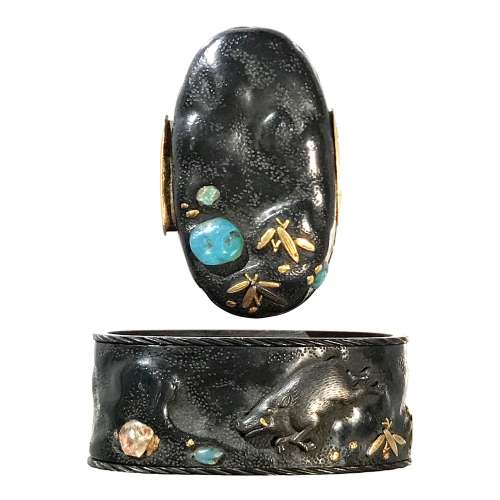 Signature: Unsigned
Signature: UnsignedFuchi-kashira with rock and boar (iwa ni inoshishi zu) motif. Inlay of precious stones or colour glass. Shakudō, gold, gemstones. Technique: Sukibori zogan kiniroe.
Fuchi: 36 x 21 x 14 mm; Weight: 22 g; Kashira: 32 x 17 x 5 mm; Weight: 8 g; Material : Shakudō; Gold; Gemstones (Chalcedony and Rose Quartz). Possibly, Owari school. -
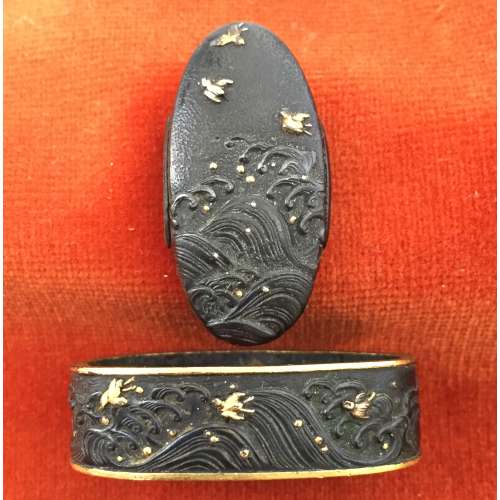 Fuchi: 37 x 21 x 11 mm; Weight: 13 g Kashira: 34 x 16 x 6 mm ; Weight: 10 g Material : Shakudo; Gold. Signature: Unsigned Technique: Sunameji Sukibori Zogan Decoration: Nami Chidori zu (wave & plover)
Fuchi: 37 x 21 x 11 mm; Weight: 13 g Kashira: 34 x 16 x 6 mm ; Weight: 10 g Material : Shakudo; Gold. Signature: Unsigned Technique: Sunameji Sukibori Zogan Decoration: Nami Chidori zu (wave & plover)


